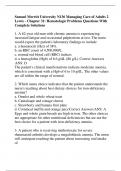Exam (elaborations)
Samuel Merritt University N136 Managing Care of Adults 2 Lewis - Chapter 31: Hematologic Problems Questions With Complete Solutions
- Course
- N136
- Institution
- Samuel Merritt University
Samuel Merritt University N136 Managing Care of Adults 2 Lewis - Chapter 31: Hematologic Problems Questions With Complete Solutions
[Show more]



